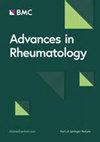Anti-protein phosphatase magnesium-dependent 1A-IgM levels in patients with active ankylosing spondylitis: a potential biomarker
IF 2.1
4区 医学
Q3 RHEUMATOLOGY
引用次数: 0
Abstract
Ankylosing spondylitis (AS) has been known to have auto-inflammatory nature; hence, the efficacy of autoantibodies is low. However, studies on autoantibodies are ongoing, with some studies showing associations. Previous studies showed that anti-protein phosphatase magnesium-dependent 1A (PPM1A) IgG was increased in patients with AS and associated with radiographic progression. However, the diagnostic usefulness was limited due to relatively low sensitivity and specificity. This pilot study evaluated the diagnostic utility of anti-PPM1A-IgM and anti-PPM1A-IgG in patients with active AS. Serum samples were obtained from the registry cohort of a single tertiary center in Korea. Serum levels of anti-PPM1A-IgG/IgM were measured by direct ELISA. Receiver operating characteristic (ROC) analysis was used to predict the diagnostic sensitivity and specificity of serum anti-PPM1A-IgG/IgM. Samples were collected from 28 patients with active AS, 16 healthy controls (HCs), and 28 patients with rheumatoid arthritis (RA). Although total serum IgM was lower in the RA and AS groups than in the HC group, anti-PPM1A-IgM was significantly lower in the AS group than in the other groups. In evaluating the diagnostic utility of anti-PPM1A-IgG/IgM for AS patients compared with HCs, the area under the curve (AUC) of anti-PPM1A-IgM was 0.998 (sensitivity 96.4%, specificity 100.0%). When ROC analysis of anti-PPM1A-IgM for AS patients compared with RA patients was conducted, sensitivity was 78.6% and specificity was 71.4%, with an AUC of 0.839. Decreased anti-PPM1A-IgM levels in AS patients suggests a potential role for anti-PPM1A-IgM in the diagnosis of active AS.活动性强直性脊柱炎患者的抗蛋白磷酸酶镁依赖性 1A-IgM 水平:潜在的生物标记物
众所周知,强直性脊柱炎(AS)具有自身炎症性,因此自身抗体的疗效较低。不过,有关自身抗体的研究仍在进行中,一些研究显示两者之间存在关联。先前的研究显示,强直性脊柱炎患者的抗蛋白磷酸酶镁依赖性 1A(PPM1A)IgG 增高,并与放射学进展相关。然而,由于敏感性和特异性相对较低,其诊断作用有限。这项试验性研究评估了抗 PPM1A-IgM 和抗 PPM1A-IgG 在活动性强直性脊柱炎患者中的诊断作用。血清样本来自韩国一家三级中心的登记队列。血清中抗PPM1A-IgG/IgM的水平通过直接ELISA法测定。采用接收者操作特征(ROC)分析预测血清抗PPM1A-IgG/IgM的诊断灵敏度和特异性。研究人员采集了28名活动性强直性脊柱炎患者、16名健康对照组(HCs)和28名类风湿性关节炎(RA)患者的样本。虽然 RA 组和 AS 组的血清总 IgM 低于 HC 组,但 AS 组的抗 PPM1A-IgM 明显低于其他组。在评估抗PPM1A-IgG/IgM对AS患者与HC患者的诊断效用时,抗PPM1A-IgM的曲线下面积(AUC)为0.998(敏感性96.4%,特异性100.0%)。在对 AS 患者与 RA 患者的抗-PPM1A-IgM 进行 ROC 分析时,敏感性为 78.6%,特异性为 71.4%,AUC 为 0.839。强直性脊柱炎患者抗PPM1A-IgM水平的降低表明,抗PPM1A-IgM在活动性强直性脊柱炎的诊断中具有潜在的作用。
本文章由计算机程序翻译,如有差异,请以英文原文为准。
求助全文
约1分钟内获得全文
求助全文
来源期刊

Advances in Rheumatology
Medicine-Rheumatology
CiteScore
4.00
自引率
4.30%
发文量
41
审稿时长
53 weeks
期刊介绍:
Formerly named Revista Brasileira de Reumatologia, the journal is celebrating its 60th year of publication.
Advances in Rheumatology is an international, open access journal publishing pre-clinical, translational and clinical studies on all aspects of paediatric and adult rheumatic diseases, including degenerative, inflammatory and autoimmune conditions. The journal is the official publication of the Brazilian Society of Rheumatology and welcomes original research (including systematic reviews and meta-analyses), literature reviews, guidelines and letters arising from published material.
 求助内容:
求助内容: 应助结果提醒方式:
应助结果提醒方式:


